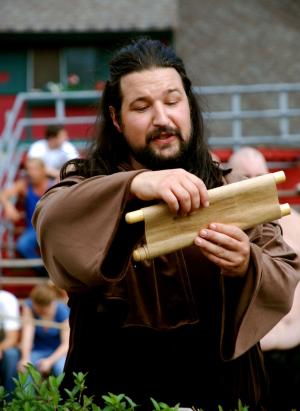| Writing Poetry posted April 1, 2016 | Chapters: |
-Prologue- 1... 
|
      |
An Abecedarian invitation reminiscent of Chaucer's, An ABC
A chapter in the book Of Poets and Poetry
Prologue to Of Poets and Poetry
by ~Dovey
|
NaPoWriMo 2016 (30 Poems in April) contest entry
 Recognized |
We are celebrating NaPoWriMo (National Poetry Writing Month) 2016 is the 20th anniversary of National Poetry Month! As a special tribute I'm hosting this contest, and as you'll read above, the Bash of the Centuries (all poets are invited to attend!)
artwork courtesy of Pixabay
As an extra tidbit, throughout the month I'll be featuring guest poets and highlighting their style or taking inspiration from their work. I'd like to introduce you the Abecedarian and Geoffrey Chaucer (1342-1400). Chaucer's most famous work is the epic poem, "The Canterbury Tales," with which you may be familiar. In "The Canterbury Tales," thirty pilgrims entertain each other with their stories on their trek to Canterbury, thus, it is only appropriate that Chaucer lead us on this expedition of poets and poetry. Today I'd like to call your attention to his poem, "An ABC", in which each stanza begins with a subsequent letter of the alphabet (although, he omitted J, U, and W)
Definition from Poets.org: The abecedarian is an ancient poetic form guided by alphabetical order. Generally each line or stanza begins with the first letter of the alphabet and is followed by the successive letter, until the final letter is reached. The earliest examples are Semitic and often found in religious Hebrew poetry. The form was frequently used in ancient cultures for sacred compositions, such as prayers, hymns, and psalms. There are numerous examples of abecedarians in the Hebrew Bible; one of the most highly regarded is Psalm 118 (or 119 by King James numbering). It consists of twenty-two eight-line stanzas, one for each letter of the Hebrew alphabet. Chaucer's "An ABC" is an excellent medieval example of the form. He crafted his translation of a French prayer into twenty-three eight-line stanzas that follow the alphabet.
Chaucer is also know as "The Knight Poet" and was married to Phillipa de Roet. He is often referred to as the "Father of English Literature," and is credited with introducing hundreds, if not thousands of words to the English language that are commonly used today. He is buried in Westminster Abbey and was the first of the literary greats to be laid to rest in what now is known as, "Poet's Corner."
Today Abecedarians are more common in children's poetry, though, there are other more serious works out there, too. The Abecedarian form gave birth to the Acrostic form that is so popular today.
Pays
one point
and 2 member cents. artwork courtesy of Pixabay
As an extra tidbit, throughout the month I'll be featuring guest poets and highlighting their style or taking inspiration from their work. I'd like to introduce you the Abecedarian and Geoffrey Chaucer (1342-1400). Chaucer's most famous work is the epic poem, "The Canterbury Tales," with which you may be familiar. In "The Canterbury Tales," thirty pilgrims entertain each other with their stories on their trek to Canterbury, thus, it is only appropriate that Chaucer lead us on this expedition of poets and poetry. Today I'd like to call your attention to his poem, "An ABC", in which each stanza begins with a subsequent letter of the alphabet (although, he omitted J, U, and W)
Definition from Poets.org: The abecedarian is an ancient poetic form guided by alphabetical order. Generally each line or stanza begins with the first letter of the alphabet and is followed by the successive letter, until the final letter is reached. The earliest examples are Semitic and often found in religious Hebrew poetry. The form was frequently used in ancient cultures for sacred compositions, such as prayers, hymns, and psalms. There are numerous examples of abecedarians in the Hebrew Bible; one of the most highly regarded is Psalm 118 (or 119 by King James numbering). It consists of twenty-two eight-line stanzas, one for each letter of the Hebrew alphabet. Chaucer's "An ABC" is an excellent medieval example of the form. He crafted his translation of a French prayer into twenty-three eight-line stanzas that follow the alphabet.
Chaucer is also know as "The Knight Poet" and was married to Phillipa de Roet. He is often referred to as the "Father of English Literature," and is credited with introducing hundreds, if not thousands of words to the English language that are commonly used today. He is buried in Westminster Abbey and was the first of the literary greats to be laid to rest in what now is known as, "Poet's Corner."
Today Abecedarians are more common in children's poetry, though, there are other more serious works out there, too. The Abecedarian form gave birth to the Acrostic form that is so popular today.

You need to login or register to write reviews. It's quick! We only ask four questions to new members.
© Copyright 2025. ~Dovey All rights reserved.
~Dovey has granted FanStory.com, its affiliates and its syndicates non-exclusive rights to display this work.


